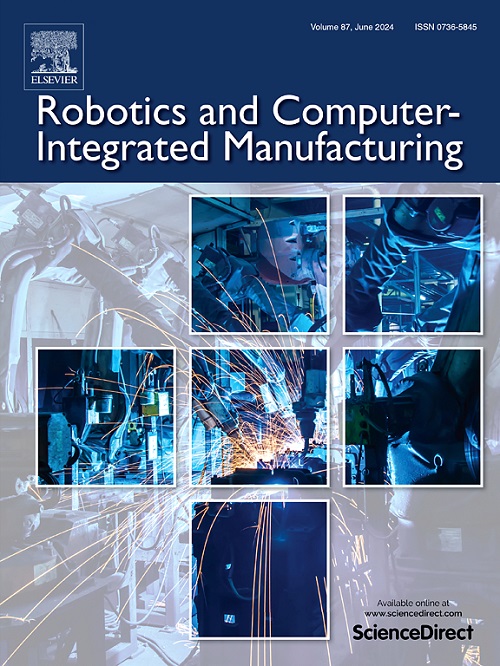A dual-arm robotic cooperative framework for multiple peg-in-hole assembly of large objects
IF 11.4
1区 计算机科学
Q1 COMPUTER SCIENCE, INTERDISCIPLINARY APPLICATIONS
引用次数: 0
Abstract
Single peg-in-hole assembly of small objects has been researched extensively. However, these studies limit applicability to multiple peg-in-hole assembly of large objects, due to the complex contact state, and the large size and weight of the objects. To address these challenges, this paper proposes a dual-arm cooperative multiple peg-in-hole assembly framework (DAC-MPiH) for large objects, leveraging the capabilities of dual robots to manage larger, heavier objects. The DAC-MPiH framework comprises three key components: dual-arm force/position coordination, external force/torque estimation, and an eight-stage assembly strategy. The proposed framework integrates a compliant dynamical system (CDS) into both inner and outer control loops, ensuring robust force/position coordination and stable manipulation at the object level. The framework introduces an object parameter estimation method based on a virtual center of mass and least squares to enhance the accuracy of external force/torque estimation. The assembly strategy includes four preparation stages and four assembly stages, utilizing a CDS-based variable impedance and variable reference force controller for stable adjusting, and a hybrid force/position controller for efficient rotating. Experiments were conducted on a dual-arm robotic platform, and the results demonstrate the effectiveness of the proposed method in achieving stable and efficient multiple peg-in-hole assembly of large objects.
大型物体多钉孔装配的双臂机器人协作框架
小物体的单钉孔装配技术得到了广泛的研究。然而,由于接触状态复杂,且物体的尺寸和重量较大,这些研究限制了大型物体的多孔内钉装配的适用性。为了解决这些挑战,本文提出了一种用于大型物体的双臂协作式多钉孔装配框架(DAC-MPiH),利用双机器人的能力来管理更大、更重的物体。DAC-MPiH框架包括三个关键组件:双臂力/位置协调、外力/扭矩估计和八阶段装配策略。所提出的框架将柔性动力系统(CDS)集成到内部和外部控制回路中,确保了鲁棒的力/位置协调和对象级的稳定操作。该框架引入了一种基于虚拟质心和最小二乘的目标参数估计方法,以提高外力/扭矩估计的精度。该装配策略包括4个准备阶段和4个装配阶段,利用基于cds的变阻抗和变参考力控制器进行稳定调节,利用力/位置混合控制器进行高效旋转。在双臂机器人平台上进行了实验,结果证明了该方法在实现大型物体的稳定、高效的多孔钉装配方面的有效性。
本文章由计算机程序翻译,如有差异,请以英文原文为准。
求助全文
约1分钟内获得全文
求助全文
来源期刊
CiteScore
24.10
自引率
13.50%
发文量
160
审稿时长
50 days
期刊介绍:
The journal, Robotics and Computer-Integrated Manufacturing, focuses on sharing research applications that contribute to the development of new or enhanced robotics, manufacturing technologies, and innovative manufacturing strategies that are relevant to industry. Papers that combine theory and experimental validation are preferred, while review papers on current robotics and manufacturing issues are also considered. However, papers on traditional machining processes, modeling and simulation, supply chain management, and resource optimization are generally not within the scope of the journal, as there are more appropriate journals for these topics. Similarly, papers that are overly theoretical or mathematical will be directed to other suitable journals. The journal welcomes original papers in areas such as industrial robotics, human-robot collaboration in manufacturing, cloud-based manufacturing, cyber-physical production systems, big data analytics in manufacturing, smart mechatronics, machine learning, adaptive and sustainable manufacturing, and other fields involving unique manufacturing technologies.

 求助内容:
求助内容: 应助结果提醒方式:
应助结果提醒方式:


